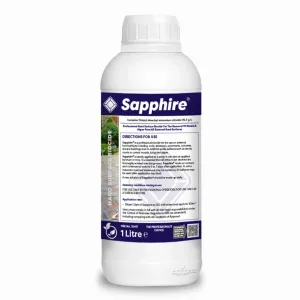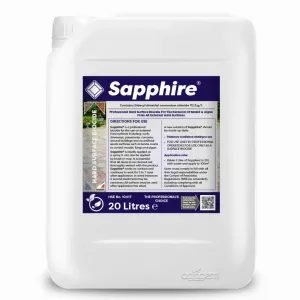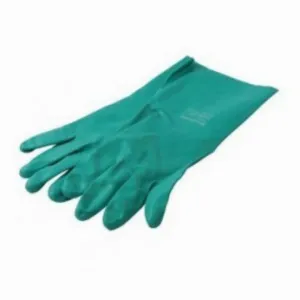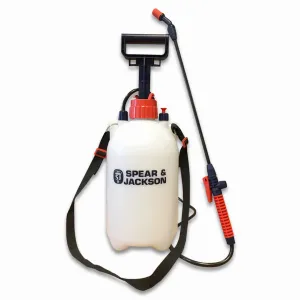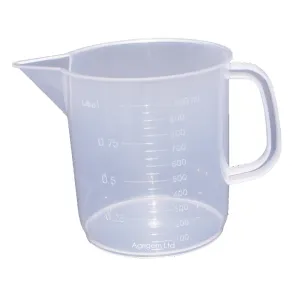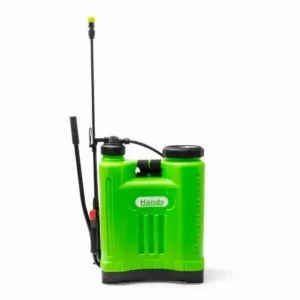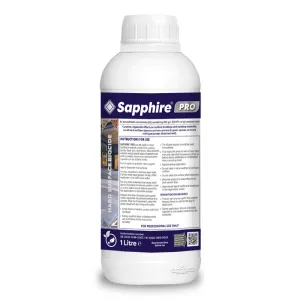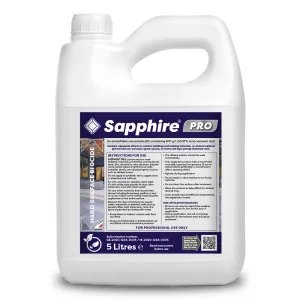Hard surface cleaners such as Sapphire are typically designed to eliminate algae, lichen, dirt and similar growth on various hard surfaces such as driveways, sidewalks, roofs and patios. Sapphire is a standout product in its field. It can be used on all hard surfaces including concrete, roofs, patios, wood, tennis courts, glass, plastic and block paving. The biocide is made up of a dynamic combination of anti-bacterial disinfectant and will cover up to 4 times the area of various other brands. This is down to the strength of Sapphire and also due to its special surfactant system which allows the active ingredients to penetrate quicker and deeper than other brands.
With Sapphire, there’s no need to scrub or pressure wash – just dilute and apply. Depending on the weather, Sapphire typically works from initial contact and also prevents re-growth. It contains zero bleach or acids and is also readily biodegradable, meaning that that it can be broken down relatively quickly by microorganisms under typical environmental conditions.
How to apply Sapphire
Sapphire can be applied via knapsack, boom sprayer or watering can.
If you have a large area to cover, opt for a boom sprayer – a product that’s specially designed for large scale use. To create a strong formula, mix 10L of Sapphire per 200L of water, or for a weaker solution opt for 5L per 200L of water.
For smaller areas choose a knapsack. To create a strong formula, mix 1L of Sapphire per 20L of water or for a weaker solution mix 500ml per 20L of water.
Only covering a small patio area? Then you can use a watering can. For a standard watering can, mix 0.25L of Sapphire with 5L of water.
Follow these steps when using Sapphire
- Read the instructions: Always read and follow the instructions provided by the manufacturer on the product label. This includes safety precautions, application rates, and any specific recommendations.
- Choose a dry, sunny time: Sapphire works immediately, but also continues to work for a further 5-7 days to prevent re-growth of weeds and moss, so it’s best to choose a period of time when there will be little to no rain to prevent run off. The active ingredients in Sapphire are activated by sunlight, so try to choose a sunny day to maximise results.
- Prepare the area: Remove any loose debris, leaves, or other materials from the surface. Sweep or clean the area to ensure good contact between the moss killer and the moss.
- Protect surrounding plants: Avoid getting Sapphire on plants, flowers and vegetation by covering them before application.
- Wear PPE: Protective equipment is necessary when using chemicals and biocides. Make sure you protect your feet and hands. You can get everything you need on our Health & Safety page.
- Dilute Sapphire with water:
- If you have a large area to cover, opt for a boom sprayer – a product that’s specially designed for large scale use. To create a strong formula, mix 10L of Sapphire per 200L of water, or for a weaker solution opt for 5L per 200L of water. If you’re covering a large area and want to keep track of the areas you’ve treated, then consider using a blue dye indicator as a guide.
- For smaller areas choose a knapsack. To create a strong formula, mix 1L of Sapphire per 20L of water or for a weaker solution mix 500ml per 20L of water.
- Only covering a small patio area? Then you can you a watering can. To create a strong solution, using a standard watering can, mix 0.25L of Sapphire with 5L of water.
- Allow time for action: Sapphire will take effect straight away, but it’s best to allow time for it to fully dry before cleaning away lifted weeds, moss and grime. We recommend waiting three days for Sapphire to take action before washing your treated area.
- Clean up: After the recommended waiting period, clean the treated area. This may involve rinsing or brushing away the dead moss and residue.
- Repeat if necessary: Depending on the severity of the moss infestation, you may need to repeat the application as directed by the product instructions.
Continual Maintenance
To address the buildup of moss and algae on hard surface, consider the following measures.
- Regular cleaning: Periodically clean hard surfaces such as driveways, sidewalks, and patios to remove debris and prevent moss and algae from establishing themselves. Use a stiff brush or pressure washer to scrub away existing growth.
- Improve drainage: Ensure proper drainage around your property to prevent water from pooling on hard surfaces. Adequate drainage can help minimize the conditions that promote moss and algae growth.
- Trim trees and plants: Prune overhanging branches and trim nearby vegetation to increase sunlight exposure on hard surfaces. This can inhibit moss and algae growth by reducing shaded areas.
- Apply moss and algae control products: Consider using moss and algae control products, such as moss killers or inhibitors, especially in areas prone to buildup. These products are designed to prevent and eliminate moss and algae growth.
- Seal surfaces: Applying a sealant to hard surfaces can create a protective barrier that makes it more difficult for moss and algae to take hold. Sealants can also help in preventing moisture penetration.




